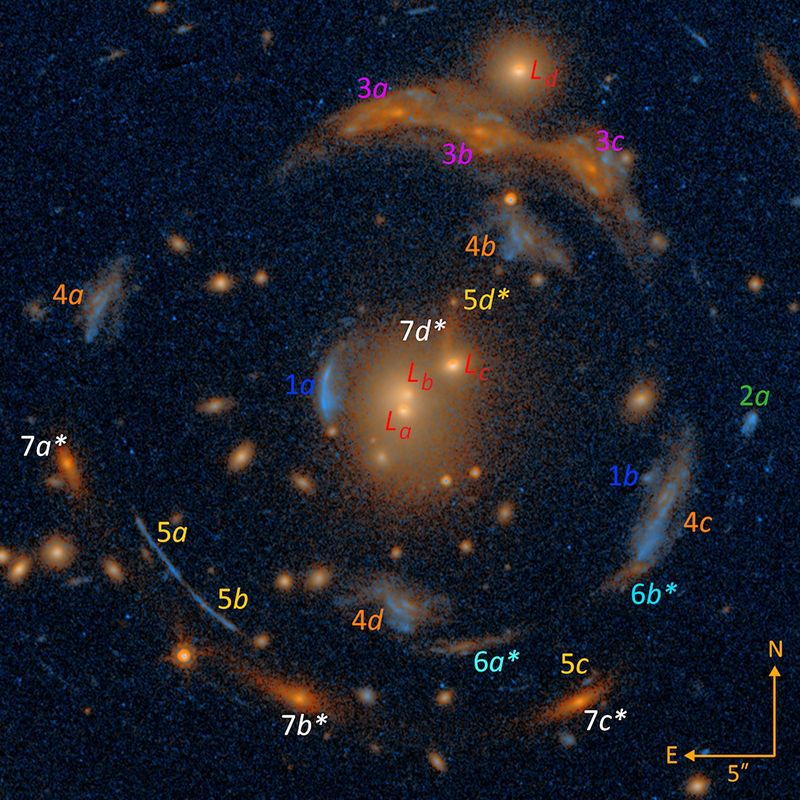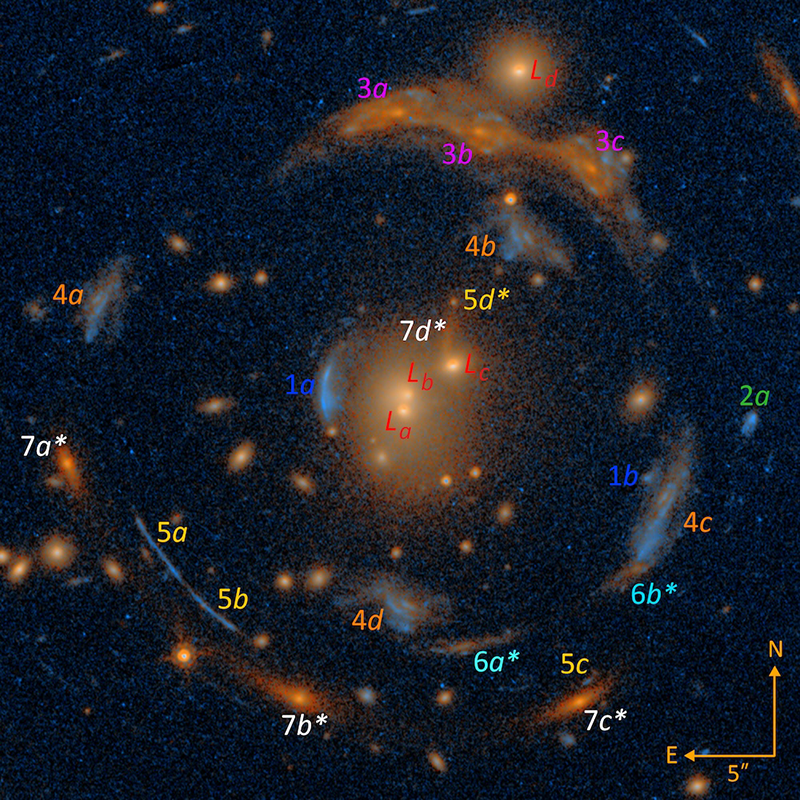An Extraordinary Cosmic Alignment
Sometimes, the stars align just right. Researchers have discovered a perfect cosmic alignment involving a cluster of massive galaxies, acting as a “foreground” lens, and seven other galaxies lying in the lens’ background [1]. The lens, 5 billion light years away from Earth, warps space-time in a way that distorts and magnifies the background galaxies’ images. Dubbed the Carousel Lens because it consists of a carousel-like pattern of concentric images, the system offers an exceptionally powerful tool for probing the distribution of dark matter within the galaxy cluster.
When light from a distant source travels through the cosmos, its trajectory gets bent by regions of space containing galaxies or galaxy clusters that act as gravitational lenses. If the matter density in such lenses is sufficiently large, so-called strong lensing can produce multiple images, arcs, or rings of objects in the lens background. Occasionally, a configuration of objects aligns nearly perfectly with an observer on Earth, creating a strong gravitational lens. That’s the case for the Carousel Lens, with a massive foreground cluster in the same line-of-sight as seven background galaxies. Finding such an arrangement is like finding eight aligned needles in a haystack, according to David Schlegel, an astrophysicist at the Lawrence Berkeley National Laboratory in California.
In 2019, researchers used a supercomputer to sift through wide-area observations made by the Dark Energy Survey, identifying the cluster as a possible strong-lens system [2]. The identification was conclusively established in 2021 [3]. In that work Xiaosheng Huang of the University of San Francisco, along with Schlegel and UCLA graduate student William Sheu and other colleagues, spotted this feature in a data release from the Dark Energy Spectroscopic Instrument (DESI) Legacy Imaging Survey. Neural network analyses of morphologies and colors provided strong hints that the objects constituted a strong lensing system. The final confirmation came from images obtained by the Hubble Space Telescope (HST). “My jaw dropped when I saw this HST image,” says Schlegel. Multiple images of each background galaxy formed a concentric pattern around the foreground cluster—the result of the images being curved, stretched, and reflected by the warped space-time of the lens (Fig. 1).
Schlegel and his team then used spectroscopy data collected by the MUSE instrument at the Very Large Telescope in Chile to determine the redshifts—or distances—of the lensed galaxies. Spanning 7.6 to 12 billion light years away from Earth, these distances approach the limit of the observable Universe (13.8 billion years). Using a relatively simple model of lensing to fit the images, the researchers determined several observable features, including a rare Einstein cross—a configuration in which a single object produces four separate images arranged in a cross around the lens.
This pattern of multiple images about the lens’ center implies that the mass distribution within the lens—which mostly comprises dark matter—is symmetric. Schlegel says that this simplicity makes the system amenable to high-precision studies that would not be possible for the more complicated lensing systems that have been previously observed. “This is one of the best systems I know of for measuring the distribution of dark matter in galaxies,” says Schlegel. The lensed images of each galaxy serve as a measurement of the mass of dark matter in the foreground galaxy cluster. By having seven sources at different distances, researchers can combine multiple measurements to greatly improve the precision with which the mass distribution can be constrained.
“The number of lensed sources in this system and the quality of their imaging provides strong mass-model constraints relative to other clusters of similar mass,” says Kenneth Wong, an assistant professor at the Research Center for the Early Universe at the University of Tokyo. He points out that the lens model presented by the researchers suggests a steeper slope for the mass profile near the center of the cluster compared to what would be expected from established dark matter models—a finding that would be very surprising. But this conclusion needs to be confirmed through more detailed modeling, he says.
The Carousel system could be useful in tackling other cosmological questions related to dark energy and to the expansion of the Universe. In particular, this lensing system might help in resolving the Hubble tension—a discrepancy in measurements of the current expansion rate, labeled H0. If a supernova or other transient event occurs in one of the background galaxies, the time delay of the supernova light appearing in the multiple images could be used to constrain H0. Thanks to the precise knowledge of matter distribution in the Carousel Lens, this measurement could be much more accurate than similar measurements obtained with other gravitational lenses.
“I would not have guessed we would have been so lucky to find such an alignment of so many galaxies,” Schlegel says. “This tells me there are probably many other discoveries to be made [in DESI’s billion-galaxy catalog] for anyone clever enough to figure out what to look for.” These exceptional alignments would be particularly useful for studying the dark and luminous matter distributions of high-redshift galaxies, which are otherwise hard to probe given their distance, he says.
–Rachel Berkowitz
Rachel Berkowitz is a Corresponding Editor for Physics Magazine based in Vancouver, Canada.
References
- W. Sheu et al., “The Carousel Lens: A well-modeled strong lens with multiple sources spectroscopically confirmed by VLT/MUSE,” Astrophys. J. 973, 3 (2024).
- C. Jacobs et al., “An extended catalog of galaxy–galaxy strong gravitational lenses discovered in DES using convolutional neural networks,” Astrophys. J., Suppl. Ser. 243, 17 (2019).
- X. Huang et al., “Discovering new strong gravitational lenses in the DESI Legacy Imaging Surveys,” Astrophys. J. 909, 27 (2021).





